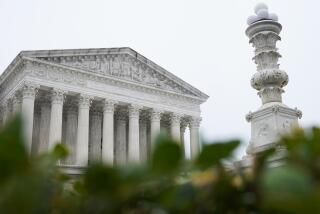Do race and gender matter for the Supreme Court?
Today’s topic: Much has been made of the fact that Sonia Sotomayor would be the first Latina justice, and sitting Justice Ruth Bader Ginsburg has said she feels “lonely” as the only woman on the bench. How much, if at all, does the ethnic and gender diversity of the Supreme Court bench matter?
Why values and life experiences matter
Point: Erwin Chemerinsky
As a woman, a Latina and a person from a disadvantaged background, Sonia Sotomayor will bring to the Supreme Court life experiences that are absent or largely unrepresented among the current justices. Her life experiences will matter enormously for her as she approaches many legal issues. Perhaps even more important, she will bring perspectives that undoubtedly at times will influence her colleagues and perhaps a majority of the justices.
Every first-year law student quickly learns that judges, and especially Supreme Court justices, often have discretion in deciding cases. How this discretion is exercised is often a product of the judges’ life experiences and values. This, of course, is not true in every case or maybe even in most cases. But it is undeniably so for many decisions, many of which are the most important facing the Supreme Court.
Cases involving fundamental constitutional rights or equal protection frequently turn on the question of whether the government has a compelling interest for its action. For example, in cases that examine the affirmative action practices of colleges and universities, justices have agreed that the issue has been whether diversity in the classroom is a compelling government interest. There is no way this question can be answered by parsing the text of the Constitution or understanding the intent of the framers. This is a question of values, and how a justice answers it is inherently based on one’s life experiences and ideology.
Numerous constitutional provisions require such value choices by the justices. Cases concerning the 4th Amendment, for instance, require that courts consider what is a reasonable expectation of privacy and whether government interests outweigh it. In a case now pending before the court, the justices are being asked to decide whether school officials who strip-searched a seventh-grade girl suspected of having prescription-strength ibuprofen violated the student’s 4th Amendment protection against unreasonable searches. Having justices on the bench who were once seventh-grade girls can make a difference in how the court perceives the issue. Justices influence each other, and having diverse viewpoints can matter.
This was most clearly evident when Thurgood Marshall was a justice and could speak to his colleagues about his experience as an African American man who spent a lifetime fighting discrimination. There is little doubt that Marshall’s influence on his colleagues was a deciding factor in the outcome of several cases. Sandra Day O’Connor and Ruth Bader Ginsburg have been powerful voices on gender equality because they bring experiences different from their male colleagues.
Conservatives like to pretend that judicial decisions require no discretion, that justices should just follow the law and that their values are irrelevant. This is silly. Antonin Scalia thinks the Constitution offers no protection for abortion rights, permits public aid to private religious schools, allows prayer in public schools, demands a ban on affirmative action and allows evidence gained improperly to be used against suspects in criminal cases. Unless one believes that the framers’ intent aligns with the 2008 Republican platform, that Scalia’s values do indeed guide his thinking on constitutional matters is undeniable. This is true of all justices.
This is not to say that all African Americans, all Latinos or all women share the same views and life experiences. This too would be a silly position. But it is to say that in our society, factors such as race, gender and social class influence our lives and how we are treated. These experiences help shape how a person approaches legal issues and how a judge decides cases.
Sotomayor has a life story unlike anyone who ever has sat on the Supreme Court. She will be a wonderful role model for girls, Latinos, those with lifelong serious illnesses and children being raised by families of modest means. She will bring all of this to the bench, and the Supreme Court will be much better off for it.
Erwin Chemerinsky is dean of the UC Irvine School of Law.
Judge Sotomayor by her cases, not her background
Counterpoint: Ilya Somin
The racial and gender composition of the Supreme Court has an important symbolic significance. Thurgood Marshall’s selection as the first African American Supreme Court justice was a milestone. So too with Sotomayor’s appointment, even though she may not actually be the first Hispanic Supreme Court nominee. Latinos have faced considerable prejudice over the course of American history, and the gradual entry into the mainstream epitomized by Sotomayor’s appointment represents genuine progress.
At the same time, we must remember that a justice’s impact is primarily determined by the cases she decides. A Supreme Court nominee should be judged more by the content of her legal opinions than by the color of her skin. Unfortunately, several of Sotomayor’s decisions raise serious questions about her willingness to fully protect important constitutional rights, including some that are of particular significance to minorities, the poor and the politically weak.
In 2006, Sotomayor joined one of the worst constitutional property rights decisions of recent years, an unsigned opinion in Didden vs. Village of Port Chester. In this case, Sotomayor’s 2nd Circuit Court of Appeals panel ruled that that the 5th Amendment requirement that condemnations must be for a “public use” did not forbid the use of eminent domain to take property from owners who had refused to pay $800,000 to a politically influential developer who threatened to have the land taken from them unless they paid him the money. The ruling was in part based on the Supreme Court’s 2005 decision in Kelo vs. City of New London, which defined “public use” extremely broadly. However, Kelo emphasized that “the mere pretext of a public purpose, when its actual purpose was to bestow a private benefit,” was not enough to count as a “public use.” It is difficult to imagine a more clearly pretextual taking than this one, because the owners’ property would not have been condemned if not for their refusal to fork over extortion money to a private developer.
Unconstrained use of eminent domain disproportionately victimizes minorities and the poor, a point the National Assn. for the Advancement of Colored People emphasized in its amicus brief in Kelo. Sotomayor’s willingness to go even further than Kelo did in undermining constitutional property rights is troubling.
In Doninger vs. Niehof, Sotomayor supported a ruling that a public school could punish a student for speech harshly critical of school officials in an Internet blog post written outside the school. As liberal scholars Jonathan Turley and Paul Levinson have emphasized, this ruling poses a serious threat to the free speech rights of public school students. Students who criticize school officials or express unpopular views are especially likely to suffer.
Finally, although Sotomayor’s inspiring life story is an important sign of racial progress, her attitude toward the role of race and ethnicity in judicial decision-making is not. In a 2001 speech, she said that she hopes that “a wise Latina woman with the richness of her experiences would more often than not reach a better conclusion than a white male [judge] who hasn’t lived that life,” and generally expressed a belief that judges should base their decisions in part on their racial and gender backgrounds. It is inevitable that personal background will influence judicial decision-making to some degree. As Sotomayor has noted, it has often had a negative effect on the decisions of white male judges in the past. But I much prefer a jurist who strives to set aside her ethnicity in making decisions to one who believes, as Sotomayor does, that we should embrace the fact that “our gender and national origins may and will make a difference in our judging.”
Erwin, you point out that judges sometimes face “value questions” that they might answer on the basis of “life experience” and “ideology.” In my view, such questions are better addressed through objective analysis of legal argument, divorced as much as possible from consideration of the judges personal background, especially their racial or gender identity. I agree with your point that it is important to have “diverse views” on the court. However, judges can draw on diverse theories of legal interpretation without basing decisions on their racial or gender identities. Jurists with divergent ideological and legal perspectives will have inevitable disagreements, often even if they have very similar backgrounds. But those disagreements should be based on an effort to address legal issues as impartially as possible, not on “values” derived in large part from one’s ethnicity or gender.
If basing decisions in part on race and gender is legitimate for female and minority judges, presumably it is also permissible for white male ones. In a world where white male jurists still predominate, this is not an outcome that political liberals -- or anyone -- should welcome.
Ilya Somin, an assistant professor at George Mason University School of Law, blogs at the Volokh Conspiracy.
More to Read
A cure for the common opinion
Get thought-provoking perspectives with our weekly newsletter.
You may occasionally receive promotional content from the Los Angeles Times.










